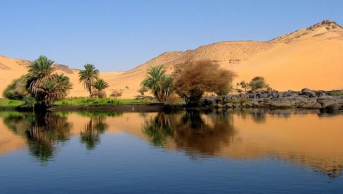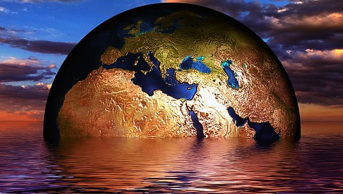Iran’s Water Crisis and its Regional Effects

Voices risingin Iran in recent weeks indicate that the country has beenincreasinglygoing through a water crisis. The wrong and inadequate water managementwhich has been the case for many years, along with the increasing negative consequences of climate change, has led to rapid worsening of the water problem in Iran. The water problem from which Iran, which is among the countries with the largest surface area and population in the Middle East, poses a risknot only to itself, but also to the whole region at large. However,if well managed, Iran’s water management problems may also allow for new transboundary cooperation schemes and investment opportunities, and thus; economic development scenariosfor the entire region.
There are many interconnected dimensions of Iran's growing water crisis. Among them are the challenges of meeting urban water demands, the problems caused by agricultural irrigation needs, the environmental problems brought about by failures in water management, and issues regardingtransboundary water sharing.
Iran is not considered as one of the lucky countries in terms of water due to its geographical and climatic conditions. A large part of the country has inadequate rainfall figures. Except for a narrow lane along the Caspian Sea, Iran hosts semi-arid and arid climatic features, and some part of the country consists of desert. In this framework, the water shortage in Iran has always been a phenomenon that has to be watched out fora long ago. However, the lack of water resources that did not constitute amajor problem till the 20th century due tothe traditional lifestyle prevailing in the country and the relatively efficient use of existing water resources has increasingly turned into a problematic issue because of industrialization, migration from rural to urban areas, massive population increases and increasing per capita water consumption in parallel to modern life.
Even in the years before the 1979 Revolution, a water crisis had loomed large on the horizon in Iran. The development pace, which had not been successful enough in the Shah period, left its place to the destructiveness of the Iran-Iraq War in the following years, and due to the increasing economic pressures, the efforts to overcome the water problems of the country, despite considerable oil revenues; could not reach the desired success, and today’s more complex level has been reached.
After the Islamic Revolution, the phenomenon of migration to cities rapidly drove the major cities of Iran under extreme water pressure, and population density in many urban areas in the country rose to the point where water supplies from remote regions became compulsory. It is known that the population of Tehran, the most prominent example in this regard,has increased more than six times in the last sixty years. Even worse, the fact that the urban water consumption per capita is well above the world average, despite the current water constraint, also denotes largelywasteful use. According to the generally accepted approach, 100-120 liters per day is the limit for one person's reasonable water use requirement. On the other hand, daily water use per person in Tehran is around 400 liters. Besides, due to the old water infrastructure, a serious amount of water is leakinginto the soil before reaching the taps.
Under the pressure to solve mounting urban water demands, the Tehran administration has turned its face towards politically easier-to-manage, supply-oriented solutions. For, it is known that demand-oriented solutions (e.g. full cost of water pricing) can sometimes lead to dissatisfaction in large public segments. In this framework, transfer of water from remote areas to the metropolitan zones, in other words,inter-basin water transfers have become one of the most substantial issues of Iran's water agenda. Nevertheless, this solution has two major drawbacks.
First, the presence of water in the area where water is withdrawn can be seriously threatened. Projects to be carried out without adequate socio-economic and environmental impact assessments can trigger some developments in a way that will not be limited only on the water realm against the administration in Iran, which is an ethnic mosaic (the only exception isthe purification of water by means of desalination fromsalinewater sources such as the Caspian Sea or the Oman Seawith a view ofdelivering it to urban centers, which is an expensive alternative). Secondly, it is mentioned that water transfers contribute to the persistence of the same erroneous forms of water use in the recipient region, trigger new migration waves, and that in the long run, it actually worsens the problem thatit supposed to resolve. Hence, the Iranian government is squeezed betweenon the one hand relying upon projects that can be quickly implementedfor addressingurgent water needs in order to cope with urban water problems, and endure their long-term consequences; and demand-centered solutions, and solutions that will achieve gradual success, such as increased education and awareness, on the other.
Iranian agriculture is also increasingly affected by the water crisis. Although Iran is now a country with a predominantly urban population, rural/agricultural populationstill maintains its importance in severalcritical areas. These regions are already poorer than urban centers, and in many cases they are made up of people from different ethnic origins. Water constraint reduces the revenue-generating agricultural activities. In this case, people move towards the bottom of the povertyspiral or abandon their fields,i.e. production. The fact that various ethnic groups get poorer brings aboutthe well-known risks. And the population leaving agricultural life also has three drawbacks. Firstly, agricultural production declines, and the dependency of the country in the context of food security increases. Secondly, erosion and desertification takes place much easier and faster in the lands where no agricultural production exists.Permanent loss of agricultural areas and growing desertification are very critical problems for Iran. And finally, the labor force that was previously employed in agricultural sector in the past comes to towns as unskilled labor, and strives to survive with grave economic difficulties and develops an oppositional attitude. For this reason, Iran works on a three-legged strategy upon water supply, which is the basic requirement of agriculture-based population. The first aims at enabling the farmers to irrigate their landsin dry seasons by means of increasing the number ofstorage facilities such as dams, ponds, etc.in its internal streams. The second leg concentrates on water projects for the purpose of delivering water from remote regions. Thirdly, new projects are carried outon transboundary water resources. This third option has the potential to create disturbing effects about critical water balances in the region; reminding us the actions that could harm the stability in the Middle East, and even in Central Asia.
It is to Iran's benefit that the current tensions with Iraq and Afghanistan have been replaced by the efforts of equitableallocation of the transboundary water resources. In relation to the water crisis in its region,Iran blames 'irrational' dam projects in its neighbors, but the fact that Iran is one of the most dam-building countries in the world constitutes a contradiction to this given argument. In this framework, the approach that is beneficial to the interests of the region in general, and of Iran in particular, is to work towards an ideal of reaching an agreement upon principles.
On the other hand, supplying water in agriculture is far from being a solution on its own - as long as irrational practices continue to be in place. Similar to the disappearance of the Aral Sea in Central Asia due to excessive water withdrawal with the purpose of increasing cotton production,the Lake Urmia in Iranis currently shrinking. Extensive and expensive projects are needed to rescue the LakeUrmia. It is also a known fact that many wetlands in the country are permanently being destroyed due to excessive use of water for agricultural purposes.
The Iranian government pays a substantial attention to the climate change in relation to the water crisis that the country has been undergoing, and in this framework,Iran plays an active role in global climate change politics. It is a reality that climate change has a significant negative impact on the Iranian territories, but this is to the extent not to overshadow the irrational and unsuccessful water management experience of the countrylasting for many years. The most important threshold in Iran's water crisis is confined to solutions of country’s internal and structural problems.









